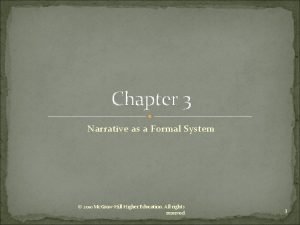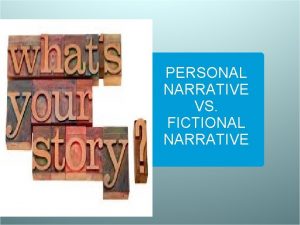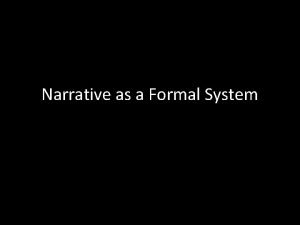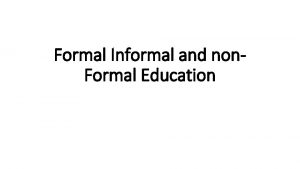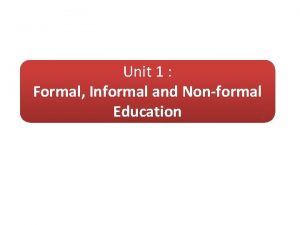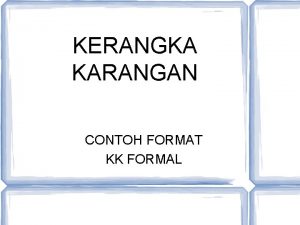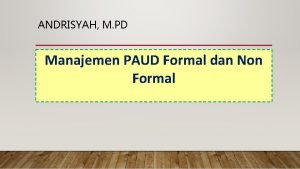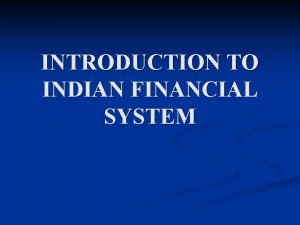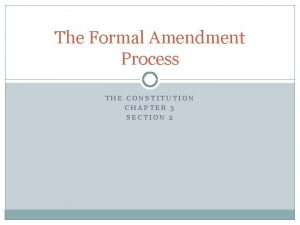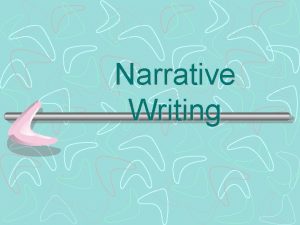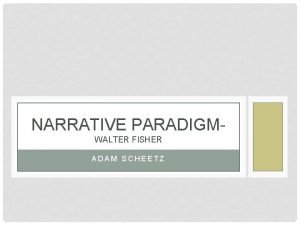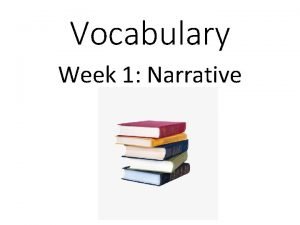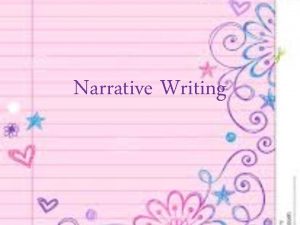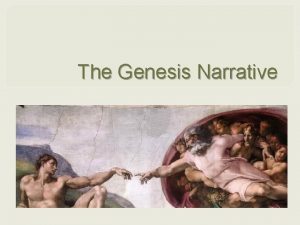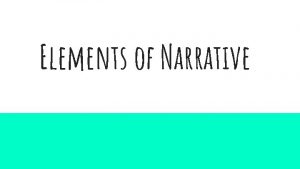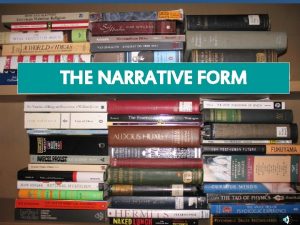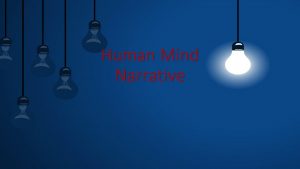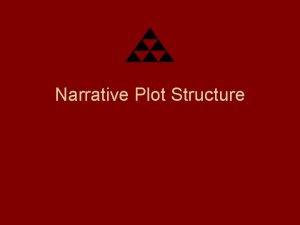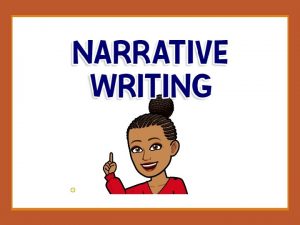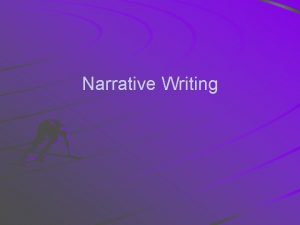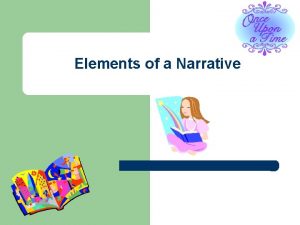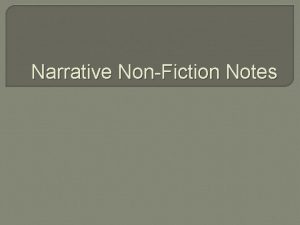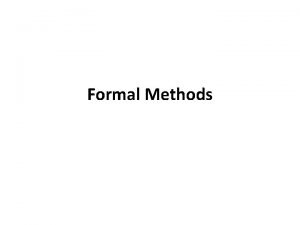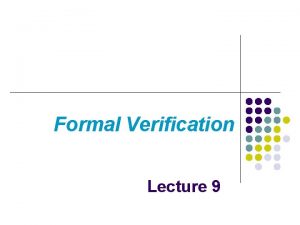Chapter 3 Narrative as a Formal System 2010























- Slides: 23

Chapter 3 Narrative as a Formal System © 2010 Mc. Graw-Hill Higher Education. All rights reserved. 1

Principles of Narrative Construction �Narrative form tells a story. �While common in fiction films, it can be employed in other types of films. �Narrative construction relies on the viewer to pick up cues, anticipate action and recall information. © 2010 Mc. Graw-Hill Higher Education. All rights reserved. 2

What is Narrative? �A chain of events in cause-effect relationship occurring in time and space. �Narratives may also make use of parallelism. © 2010 Mc. Graw-Hill Higher Education. All rights reserved. 3

Plot and Story �Story: all the events in a narrative, both explicitly presented and inferred. �Diegesis are elements that are assumed to exist in the film world. �Plot includes non-diegetic elements and everything visibly and audibly presented, but not what is presumed or inferred. © 2010 Mc. Graw-Hill Higher Education. All rights reserved. 4

Cause and Effect �Usually triggered by characters, but could be events or circumstance. �Viewers look for causal motivation and this can create mystery, suspense or other reactions. © 2010 Mc. Graw-Hill Higher Education. All rights reserved. 5

Time �Time shapes our understanding of narrative. �Temporal order refers to the order of story events. �Story time is constructed on the basis of what the plot presents, even though that might not be in chronological order. © 2010 Mc. Graw-Hill Higher Education. All rights reserved. 6

Time �Story duration is the period of time referred to in the film. �Plot duration includes the stretches of time depicted in the film. �Screen duration is the length of the film. �Temporal frequency is the number of times an element is presented. © 2010 Mc. Graw-Hill Higher Education. All rights reserved. 7

Space �Story space is where the story takes place �Screen space is the visible space within the frame. �Space selects certain parts of plot space and can ask the viewer to infer or imagine space. © 2010 Mc. Graw-Hill Higher Education. All rights reserved. 8

Openings and Patterns of Development �Exposition: the part of the plot that lays out important story events and character traits in the opening. �Patterns of Development: Can be motivated by time and space or by the characters, such as in a change in knowledge. © 2010 Mc. Graw-Hill Higher Education. All rights reserved. 9

Climax and Ending �Climaxes resolve causal issues by bringing the development to a high point, often involving tension or suspense. �Some films are anti-climactic and the endings remain relatively open. © 2010 Mc. Graw-Hill Higher Education. All rights reserved. 10

Story Range �Range refers to how much information the viewer is given. �Restricted: when viewer’s knowledge is restricted to that of a main character. �Unrestricted: When viewers know more and hear more than any of the characters know. �It is a continuum. © 2010 Mc. Graw-Hill Higher Education. All rights reserved. 11

Story Depth �Depth refers to how deeply the plot plunges the viewer into the character’s psychological states. �This is also a continuum that can vary between objective and subjective points of view. �The filmmaker’s choice about range and depth affects the viewer’s response to the film. © 2010 Mc. Graw-Hill Higher Education. All rights reserved. 12

Narrator �A character (within the story or not) who purports to be telling the viewer the story. �Can be objective or subjective, internal or external to the story. © 2010 Mc. Graw-Hill Higher Education. All rights reserved. 13

Narration in The Road Warrior �Max is the center of the plot’s causal chain and the viewer is restricted to Max’s range of knowledge. �This is emphasized by use of point of view shots and mental subjectivity. �Moments of unrestricted narration build suspense and create surprise. © 2010 Mc. Graw-Hill Higher Education. All rights reserved. 14

Classical Hollywood Cinema �Historically, in fiction filmmaking the action comes from individual characters as causal agents. �Time is typically subordinate to cause and effect. �Often Hollywood narrative is objective and involves closure. © 2010 Mc. Graw-Hill Higher Education. All rights reserved. 15

Narrative Form in Citizen Kane �Uses conventions of the newspaper, detective and biography genres. �The film focuses on psychological states and relationships. �It both adheres to and departs from Classical Hollywood Cinema norms and rules. © 2010 Mc. Graw-Hill Higher Education. All rights reserved. 16

Plot and Story in Citizen Kane �Scenes can be broken down into a segmentation that allows for analysis of the major divisions of the plot as well as causality and story time. © 2010 Mc. Graw-Hill Higher Education. All rights reserved. 17

Causality in Citizen Kane �Two sets of characters cause events to happen: the reporters and the people who knew Kane. �Kane’s death creates a connection between them. �Thompson’s goal drives the plot. © 2010 Mc. Graw-Hill Higher Education. All rights reserved. 18

Time in Citizen Kane �The order of plot events engages the viewer because if its complexity. �Earlier parts of the plot show the results of events viewers haven’t seen. �Later parts confirm and modify expectations viewers formed earlier. �The newsreel parallels the plot structure of the film. © 2010 Mc. Graw-Hill Higher Education. All rights reserved. 19

Motivation in Citizen Kane �The narrative revolves around an investigation into traits of a character, motivated first by the search for Rosebud. �Some motivations are left ambiguous. © 2010 Mc. Graw-Hill Higher Education. All rights reserved. 20

Parallelism in Citizen Kane �Kane’s search for happiness vs. Thompson’s search for Rosebud. �Kane’s campaign for governor vs. Susan’s opera career. © 2010 Mc. Graw-Hill Higher Education. All rights reserved. 21

Patterns of Plot Development in Citizen Kane �The flashbacks provide a clear progression and each offers a distinct type of information about Kane. �The plot remains relatively open in the end: neither Kane nor Thompson reach their goal. �Is Rosebud a resolution? © 2010 Mc. Graw-Hill Higher Education. All rights reserved. 22

Narration in Citizen Kane �We are really only offered recollections of Kane through 5 narrators, keeping us restricted in our knowledge. �Thompson is the conduit for the information. He is neutral and barely characterized. �The narrative is omniscient overall. © 2010 Mc. Graw-Hill Higher Education. All rights reserved. 23
 Narrative as a formal system
Narrative as a formal system What is a fictional narrative
What is a fictional narrative Difference between narrative and story
Difference between narrative and story What are narrations
What are narrations Tipos de lenguaje formal e informal
Tipos de lenguaje formal e informal Informal curriculum
Informal curriculum Unit 3 formal informal and nonformal education
Unit 3 formal informal and nonformal education Kurikulum tidak formal
Kurikulum tidak formal Contoh kerangka karangan formal dan non formal
Contoh kerangka karangan formal dan non formal Venn diagram formal education and nonformal education
Venn diagram formal education and nonformal education Pola komunikasi ke bawah
Pola komunikasi ke bawah Falasi informal
Falasi informal Kepimpinan dan motivasi
Kepimpinan dan motivasi Aap1 linguagem e oralidade
Aap1 linguagem e oralidade Manajemen paud formal dan non formal
Manajemen paud formal dan non formal Is earth open or closed system
Is earth open or closed system Digestive system respiratory system and circulatory system
Digestive system respiratory system and circulatory system Difference between formal and informal financial system
Difference between formal and informal financial system Formal and informal channels of communication
Formal and informal channels of communication Formal amendment process
Formal amendment process Small business server 2010
Small business server 2010 Visual studio 2010 training
Visual studio 2010 training Ul 2010
Ul 2010 Microsoft visual c express 2010
Microsoft visual c express 2010
